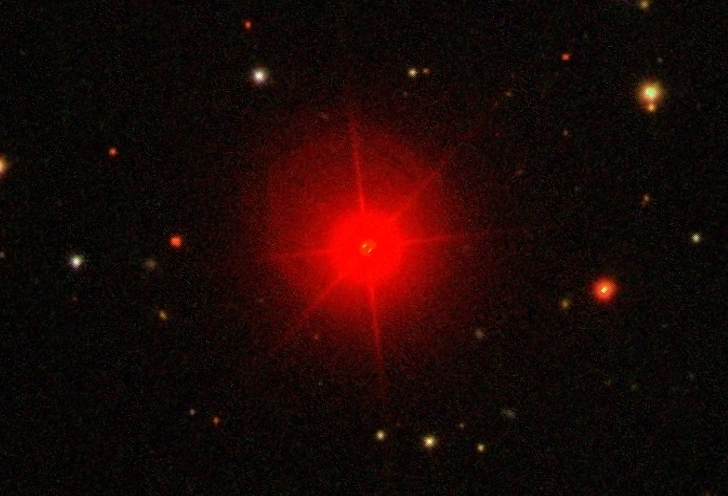News
IK Tau, a dying star at the origin of prebiotic molecules ?
 |
| IKTau is an evolved star (approximately twice the age of our Sun) surrounded by a circumstellar envelope composed of dust particles and gas. The envelope blocks most of the visible light emitted by the star that travels along the line of sight toward us. In this false color image obtained with the Aladin Sky Atlas using the Sloan Digital Sky Survey, we see the object as an intense extended red (cold) object. |
One of the objectives of astrochemistry is to understand how the chemical processes that we know on Earth take place in space. Despite the usually hostile environment, complex and often unexpected chemical processes, are not uncommon in our Universe. It is the case of IK Tau, an evolved solar-type star with an oxygen-rich envelope in one of the last stages of its life, the asymptotic giant branch phase (AGB). The star grows, by hundreds of times, and creates an envelope that gradually dilutes into the interstellar medium.
For the first time, an international research team, led by Luis Velilla from the Institute of Materials Science of Madrid (ICMM-CSIC, Spain), has made a deep spectral survey of the envelope of this oxygen rich AGB star. The researchers discovered rare molecules in the envelope confirming that this type of evolved star has a much more complex chemistry than expected. Generally, evolved stars are either oxygen or carbon rich and the latter have always been considered more chemically active and possessing a larger variety of chemical species. The studies of these two types of evolved stars are based on models that take into account this chemical differentiation. Given the results of this spectral survey, it might be necessary to change the modeling approach that has prevailed until now.
Unexpected results:
After several observing campaigns from 2009 to 2013 with the IRAM 30-meter telescope, the data revealed the presence of, approximately, 350 spectral emission lines that belong to nearly 20 molecular species bearing elements such as H-, O-, C-, N-, S-, Si- and P. For the first time, they detected in this source lines of HCO+, NS, NO, and H2CO, as well as several isotopologues of molecules previously identified (see list below*). The team also detected several high excitation lines of SO2, which are not predicted by the models for the temperature and density conditions in the innermost region of IK Tau. This would prove that oxygen rich molecular envelopes might have a chemical activity much more complex than expected.
 |
|
|
| Samples of the line identification for two particular frequency ranges observed with the IRAM 30-meter telescope. |
A data reservoir:
One of the important aspects of this work, besides the discovery of non-expected molecular species in the envelope of IK Tau, is the large amount of data to investigate this type of objects. The survey which has allowed the detection of many lines of molecules previously identified in IK Tau is not only useful as a reference for studies of the chemical evolution of solar-type stars, but it also makes necessary to adjust existing chemical models that predict the formation of molecular species in the innermost regions of oxygen rich AGB stars. The ejected outer layers of a dying star is the main phenomenon contributing to the enrichment of the interstellar medium, both in terms of quantity of elements as with regard to their chemical complexity. The study of these envelopes is key to understand how the elements react to form, first, simple molecules composed of two atoms, such as the NS and, later, molecules such as formaldehyde (H2CO), primary elements for the subsequent formation of complex organic molecules and the so-called prebiotic molecules, the building blocks for life on Earth.
*C18O, Si17O, Si18O, 29SiS, 30SiS, Si34S, H13CN, 13CS, C34S, H2 34S, 34SO, and 34SO2
More information:
This research was presented in the paper “The millimeter IRAM-30m line survey toward IK Tau”, recently published in the Astronomy & Astrophysics Journal (Volume 597, id.A25, 2017). The team is composed by Luis Velilla Prieto (Institute of Materials Science of Madrid, CSIC; Center for Astrobiology, INTA-CSIC, Spain); Carmen Sanchez Contreras (Center for Astrobiology, INTA-CSIC, Spain); Jose Cernicharo (Institute of Materials Science of Madrid, CSIC, Spain); Marcelino Agundez (Institute of Materials Science of Madrid, CSIC, Spain); Guillermo Quintana-Lacaci (Institute of Materials Science of Madrid, CSIC, Spain); Valentin Bujarrabal (National Astronomical Observatory, IGN, Spain); Javier Alcolea (National Astronomical Observatory, IGN, Spain); Christian Balança (LERMA, Paris Observatory, University of La Sorbonne, France); Fabrice Herpin (University of Bordeaux, LAB; CNRS, LAB, France); Karl M. Menten (Max- Planck Institute for Radioastronomy, Germany); and Friedrich Wyrowski (Max-Planck Institute for Radioastronomy, Germany).




